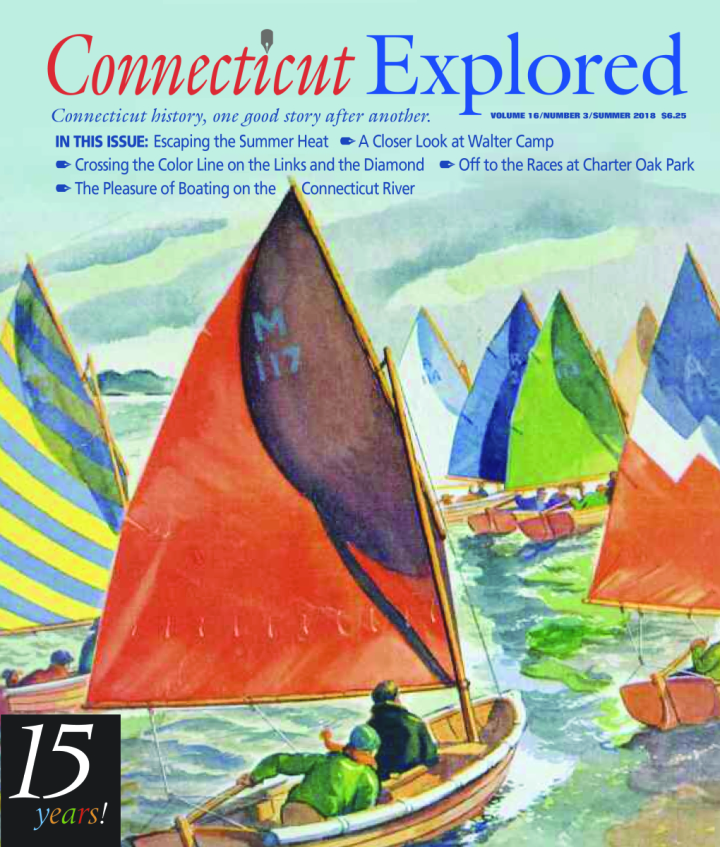(c) Connecticut Explored Inc. Summer 2018
Subscribe/Buy the Issue!
After Connecticut native Charles Goodyear invented vulcanized rubber and in 1844 patented its manufacturing process, rubber manufacturing companies using the process quickly proliferated, with many of the leading firms located in Naugatuck, Connecticut. Years of fierce competition and frequent litigation ensued, continuing until the 1892 formation of the United States Rubber Co., which consolidated nine of the leading Naugatuck companies. By the late 1890s, however, several defections from U.S. Rubber had occurred as executives of component companies left to establish their own independent firms.
In 1898 father and son George A. and Tracy S. Lewis founded The Beacon Falls Rubber Shoe Co. in Beacon Falls, Connecticut and began the manufacture of a line of high-quality products, notably rubber boots, rubber shoes, arctics, and rubber overshoes. For many years George Lewis (1843-1914) had served as treasurer and general manager of Goodyear’s Metallic Rubber Shoe Co. in Naugatuck, founded before 1860 by his father, Samuel J. Lewis. Tracy Lewis (1873-1921) graduated from Yale’s Sheffield Scientific School in 1894, joined his father in founding the new company, and assumed its presidency upon his father’s death in 1914.
Possibly under the influence of the younger Lewis, by the early 1910s Beacon Falls Rubber Shoe had begun to diversify—offering a line of versatile and fashionable canvas-topped, rubber-soled shoes to be worn while enjoying a variety of summer activities. The October 1913 issue of the company’s publication Rubber, aimed at its nation-wide sales force, showcased these shoes, highlighting the “Beacon Falls Basket Ball, Yachting and Tennis Shoes,” and indicated their suitability for track-and-field events—and dancing. In the same issue, a poem captured in verse the company’s pitch for its new line:
 Those Tennis Shoes From Beacon Falls
Those Tennis Shoes From Beacon Falls
For Bertie in the dancing hall
To Tango with his flame,
For Willie on the tennis court,
To make him win the game.
For Percy in his sailing boat,
To keep him safe on deck,
For Johnnie in the schoolroom gym,
Can’t slip and break his neck.
This Tennis with the “non-slip” sole
Is best of all yet made;
For fit and style and long-time wear
Throws others in the shade.
Under the younger Lewis’s leadership, the company expanded this line and suggested that golfing and baseball were among the summer activities that could be enjoyed wearing its shoes. By 1918, in the catalog for its “Top Notch Brand Outing Footwear,” the company acknowledged that “Rubber soled footwear has established itself as a necessary part of the summer wardrobe of every well dressed man and woman. Its use is no longer confined to athletics. In every city in the land, in the country, at the seashore and the mountains, white canvas rubber soled footwear completes the summer costume and gives the wearer desired comfort and appearance… . It is due to the fact that men and women can now get snappy style combined with the comfort of rubber soled canvas shoes that this kind of footwear has become so popular a favorite.”
It is not clear when Beacon Falls ceased manufacturing canvas-topped, rubber-soled shoes. Tracy Lewis died on April 4, 1921 and, in July of that year, the United States Rubber Co. assumed management of the company in return for company stock and a share of the profits. In 1924 an ad for the company’s “Grip-Sure” brand of shoe proclaimed, “For hiking, sailing or all around summer use they are the most comfortable shoes you ever wore.” A large advertising poster from the same year illustrated and described the complete line of “Top Notch/Canvas Rubber Sole Footwear.” Beacon Falls, however, ran deficits of nearly $500,000 in 1925 and 1926, and in 1930 all Beacon Falls manufacturing operations were moved to Naugatuck—into revamped space in the former factory of Goodyear’s Metallic Rubber Shoe Co.
 According to historian Glenn D. Babcock in History of the United States Rubber Company(Indiana University,1966), many smaller, regional companies absorbed by U.S. Rubber continued using their company names and logos, especially in areas where there was a strong regional market for their products. Beacon Falls’s line of canvas-topped, rubber-soled shoes may have been absorbed by the nationally-known “Keds” brand,” created by U.S. Rubber in 1916 when it consolidated most rubber-soled shoe manufacturing. After World War II, U.S. Rubber streamlined its operations, upgraded its aging plants, and aggressively advertised and promoted “Keds.” The Beacon Falls Rubber Shoe Co. finally became a division of U.S. Rubber in 1964.
According to historian Glenn D. Babcock in History of the United States Rubber Company(Indiana University,1966), many smaller, regional companies absorbed by U.S. Rubber continued using their company names and logos, especially in areas where there was a strong regional market for their products. Beacon Falls’s line of canvas-topped, rubber-soled shoes may have been absorbed by the nationally-known “Keds” brand,” created by U.S. Rubber in 1916 when it consolidated most rubber-soled shoe manufacturing. After World War II, U.S. Rubber streamlined its operations, upgraded its aging plants, and aggressively advertised and promoted “Keds.” The Beacon Falls Rubber Shoe Co. finally became a division of U.S. Rubber in 1964.
David Corrigan is the curator of the Museum of Connecticut History and a frequent contributor to Connecticut Explored. He last co-wrote “Connecticut’s Small Appliance Revolution” with Karen Hudkins (Summer 2017).

